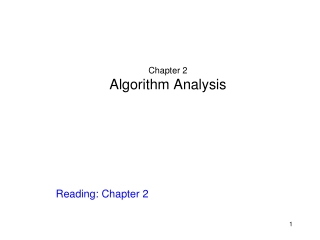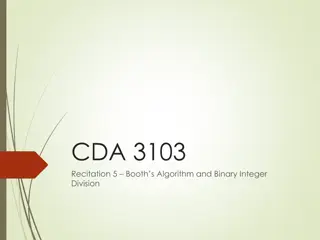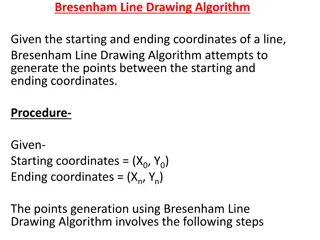Quicksort Algorithm
In this series of images, the Quicksort algorithm is visually explained step by step. Starting with initial partitioning and progressing through recursive calls, the images demonstrate how the algorithm efficiently sorts the elements. Each image provides a clear understanding of the process, showcasing how the algorithm operates and rearranges elements until the final sorted array is achieved.
Download Presentation

Please find below an Image/Link to download the presentation.
The content on the website is provided AS IS for your information and personal use only. It may not be sold, licensed, or shared on other websites without obtaining consent from the author.If you encounter any issues during the download, it is possible that the publisher has removed the file from their server.
You are allowed to download the files provided on this website for personal or commercial use, subject to the condition that they are used lawfully. All files are the property of their respective owners.
The content on the website is provided AS IS for your information and personal use only. It may not be sold, licensed, or shared on other websites without obtaining consent from the author.
E N D
Presentation Transcript
COMPARATORS + ITERATORS David Kauchak CS 62 Spring 2021
Admin Compression assignment
lessThanIndex i 5 1 2 7 8 4 3 6 start end pivot > pivot unprocessed
vals[end] is called the pivot Partitions the elements nums[start end-1] in to two sets, those pivot and those > pivot Operates in place Final result: end start pivot nums > pivot pivot
Quicksort 8 5 1 3 6 2 7 4
Quicksort 8 5 1 3 6 2 7 4
Quicksort 1 3 2 4 6 8 7 5
Quicksort 1 3 2 4 6 8 7 5
Quicksort 1 3 2 4 6 8 7 5
Quicksort 1 2 3 4 6 8 7 5
Quicksort 1 2 3 4 6 8 7 5
Quicksort 1 2 3 4 6 8 7 5
Quicksort 1 2 3 4 6 8 7 5
Quicksort 1 2 3 4 6 8 7 5
Quicksort 1 2 3 4 5 8 7 6 What happens here?
Quicksort 1 2 3 4 5 8 7 6
Quicksort 1 2 3 4 5 8 7 6
Quicksort 1 2 3 4 5 6 7 8
Quicksort 1 2 3 4 5 6 7 8
Running time of Quicksort? Worst case? Each call to Partition splits the array into an empty array and n-1 array
Quicksort: Worst case running time n-1 + n-2 + n-3 + + 1 = O(n2) When does this happen? sorted reverse sorted near sorted/reverse sorted
Quicksort best case? Each call to Partition splits the array into two equal parts How much work is done at each level , i.e. running time of a level? O(n)
Quicksort best case? Each call to Partition splits the array into two equal parts How many levels are there? Similar to mergesort, each call to Partition will throw away half the data until we re down to one element: log2 n levels
Quicksort best case? Each call to Partition splits the array into two equal parts Overall runtime? O(n log n)
Quicksort Average case? Two intuitions As long as the Partition procedure always splits the array into some constant ratio between the left and the right, say L-to-R, e.g. 9-to- 1, then we maintain O(n log n) As long as we only have a constant number of bad partitions intermixed with a good partition then we maintain O(n log n)
How can we avoid the worst case? Inject randomness into the data void randomizedPartition(E [] nums, int start, int end){ int i = randomInt(start, end); swap(nums, i, end); return partition = partition(nums, start, end); } Randomized quicksort is average case O(n log n)
What is the worst case running time of randomized Quicksort? O(n2) We could still get very unlucky and pick bad partitions at every step
Quicksort properties Stable? In-place?
Quicksort properties Stable: possible, but not the way we ve written it (and requires more storage!) In-place: yes!
Sorting summarized in-place? X X stable? Best Average O(n2) O(n2) Worst O(n2) O(n2) Notes O(n2) O(n) n swaps Selection Insertion use for partially ordered X guaranteed Merge Quick X O(n log n) O(n log n) O(n log n) O(n log n) O(n log n) O(n2) fastest in practice X
Comparable interface https://docs.oracle.com/javase/8/docs/api/java/lang/Comparable.html Interface Comparable<T> int compareTo(T other) -1: this object is less than other (technically, any negative number) 0: this object is equal to other 1: this object is greater than other (technically, any positive number)
Built-in sorting Arrays: (https://docs.oracle.com/javase/8/docs/api/java/util/Arrays.html) Collections:(https://docs.oracle.com/javase/8/docs/api/java/util/Collections.html)
Naturally sorting cards https://github.com/pomonacs622021sp/LectureCode /blob/master/SortingCards/SortableCard.java SortableCard: implements Comparable<SortableCard> Utilizes String.compareTo and Integer.compare Foreach loop! naturalSort()
Comparator: unnatural sorting https://docs.oracle.com/javase/8/docs/api/java/util/Comparator. html Create a different ordering without having to modify the class! Interface Comparator<T> int compare(T o1, T o2) -1: o1 is less than o2 (technically, any negative number) 0: o1 is equal to o2 1: o1 is greater than o2 (technically, any positive number)
Unnatural sorting Arrays: (https://docs.oracle.com/javase/8/docs/api/java/util/Arrays.html) Collections:(https://docs.oracle.com/javase/8/docs/api/java/util/Collections.html)
Unnaturally sorting cards https://github.com/pomonacs622021sp/LectureCode /blob/master/SortingCards/BridgeCardSort.java Add 20 to aces Reverse the suit ordering Reverse the number ordering bridgeOrderingSort
Iterator https://docs.oracle.com/javase/8/docs/api/java/util/Iterat or.html A way to move through all of the data in a collection Interface Iterator<E>: boolean hasNext() E next() Have we seen this before? How can we iterate through the data?
Iterator example What would we see printed?
Iterator example bananas taste good
Iterator example What would we see printed?
Iterator example bananas bananas taste good taste Each iterator has its own state!
Iterable https://docs.oracle.com/javase/8/docs/api/java/lan g/Iterable.html interface Iterable<E>: Iterator<E> iterator() Just a single method that returns an Iterator.
Why Iterable?? Any class that implements the Iterable class can be used in a foreach loop!
How to make a class Iterable Implement Iterable interface Make a private inner class that implements the Iterator interface Have the iterator method return an instance of the private inner class
An example https://github.com/pomonacs622021sp/LectureCode /blob/master/Iterable/IterableArrayList.java Each instance of the inner class will have its own count instance variable























